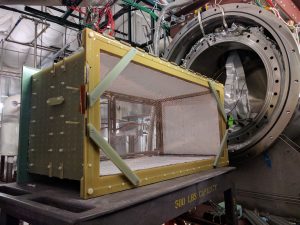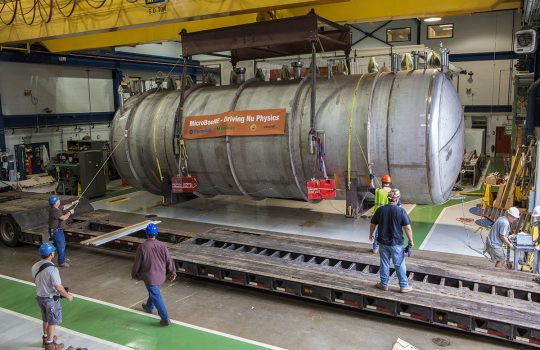
The LArIAT time projection chamber will be used to conduct a proof-of-concept test for the future DUNE detector. Photo: Jen Raaf
In particle physics, the difference of a millimeter or two can make or break an experiment. In March, the LArIAT experiment began a proof-of-concept test to make sure the planned Deep Underground Neutrino Experiment (DUNE) will work well with that 2-millimeter difference.
Specifically, scientists are looking at what will happen when you increase the space between detection wires inside the future DUNE detectors.
DUNE will measure neutrinos, mysterious particles that are ubiquitous but elusive and may hold answers to questions about the origins of the universe.
Like the future DUNE detectors, LArIAT is filled with liquid argon. When a particle strikes an argon nucleus inside the detector, the interaction creates electrons that float through the argon until they’re captured by a wire, which registers a signal. Scientists measure the signal to learn about the particle interaction.
Unlike the DUNE detectors, LArIAT does not detect neutrinos. Rather, it uses the interactions of other particle types to make inferences about neutrino interactions. And very unlike DUNE, LArIAT is the size of a mini-fridge, a mere speck compared to DUNE’s detectors, which will hold about 22 Olympic-size swimming pools’ worth of liquid argon.
LArIAT scientists use a beam of charged particles provided by the Fermilab Test Beam Facility that are fired into the liquid argon. These particles interact with matter far more than neutrinos do, so the beam results in many more interactions than a similar beam of neutrinos, which would mostly pass through the argon. The higher level of interactions is what allows LArIAT to forgo the massive size of DUNE.
Results from LArIAT may help physicists better understand other liquid-argon neutrino detectors at the DOE Office of Science’s Fermilab such as MicroBooNE and SBND.
“The point of the LArIAT experiment is to measure how well we can identify the various types of particles that come out of neutrino interactions and how well we can reconstruct their energy,” said Jen Raaf, LArIAT spokesperson.
Although LArIAT doesn’t detect neutrinos, the charged-particle interactions can give scientists clues about how neutrinos interact with argon nuclei.
“Instead of sending a neutrino in and looking at what stuff comes out, you send the other stuff in and see what it does,” Raaf said.
Interactions in LArIAT are characterized primarily by a mesh of wires that detects the drift electrons. One key factor that affects the accuracy of drift-electron detection is the spacing between each wire.
“The closer together your wires are, the better spatial resolution you get,” Raaf said. But the more closely spaced the wires are, the more wires that are needed. More wires means more electronics to detect signals from the wires, which can become expensive in a giant detector such as DUNE.
To keep costs down, scientists are investigating whether DUNE will have a high enough resolution in its measurements of neutrino interactions with wires spaced 5 millimeters apart — larger than the 3-millimeter spacing in smaller Fermilab neutrino experiments such as MicroBooNE.
Simulations suggest that it should work, but it’s up to Raaf and her team to test whether or not 5-millimeter spacing will do the job.
LArIAT uses the Fermilab Test Beam Facility, which is an important part of the equation. The facility’s test beam originates from the lab’s accelerators and passes through a set of particle detection instruments before arriving at the LArIAT detector. Scientists can then compare the results from the first set of instruments with the LArIAT results.
“If you know that it was truly a pion going in to the detector, and then you run your algorithm on it and it says ‘Oh no that was an electron,’ you’re like ‘I know you’re wrong!’” Raaf said. “So you just compare how often you’re wrong with 5 millimeters versus 3 millimeters.”
She and her team are optimistic, but committed to being thorough.
“It works in theory, but we always like to measure,” she said.
This research receives support from the Department of Energy Office of Science and the National Science Foundation.



